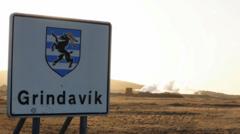As of 9:45 AM local time today, a volcanic eruption has erupted on the Reykjanes Peninsula in southwest Iceland, just north of the town of Grindavík. The Icelandic Meteorological Office (IMO) confirmed the eruption initiates after a series of earthquakes rattled the region, starting as early as 6:30 AM local time. Within an hour of the eruption, the fissure in the ground expanded to 700 meters (about 2,296 feet) and continues to grow.
In anticipation of the volcano's activity, both Grindavík and the nearby Blue Lagoon, a well-known tourist destination, undertook evacuation orders. Roads leading to and from the town remain shut, but air travel has not yet been impacted. As of 11:00 AM local time, the IMO reported that not only did the initial fissure extend southward, but a new crack has also emerged.
Officials are urging any residents in Grindavík who may have stayed to leave immediately, after reports surfaced earlier in the day that some individuals chose to ignore evacuation orders. Úlfar Lúðvíksson, the local police chief, shared that only about 40 homes currently house residents, following more extensive evacuations at the end of 2023 due to prior volcanic activity.
The active magma tunnel beneath the area measures approximately 11 kilometers (6.8 miles) in length – the longest observed since November 11, 2023, as reported by the IMO. Meteorologists noted that gas pollutants from the eruption could impact the northeast regions, including the capital area, depending on the wind direction.
The Reykjanes Peninsula has seen multiple volcanic events since 2021. It is noteworthy that the previous series of eruptions here had not been seen for around 800 years, with volcanic activities extending over several decades. Iceland is home to 33 active volcanic systems and lies along the Mid-Atlantic Ridge, the junction of two major tectonic plates.
In anticipation of the volcano's activity, both Grindavík and the nearby Blue Lagoon, a well-known tourist destination, undertook evacuation orders. Roads leading to and from the town remain shut, but air travel has not yet been impacted. As of 11:00 AM local time, the IMO reported that not only did the initial fissure extend southward, but a new crack has also emerged.
Officials are urging any residents in Grindavík who may have stayed to leave immediately, after reports surfaced earlier in the day that some individuals chose to ignore evacuation orders. Úlfar Lúðvíksson, the local police chief, shared that only about 40 homes currently house residents, following more extensive evacuations at the end of 2023 due to prior volcanic activity.
The active magma tunnel beneath the area measures approximately 11 kilometers (6.8 miles) in length – the longest observed since November 11, 2023, as reported by the IMO. Meteorologists noted that gas pollutants from the eruption could impact the northeast regions, including the capital area, depending on the wind direction.
The Reykjanes Peninsula has seen multiple volcanic events since 2021. It is noteworthy that the previous series of eruptions here had not been seen for around 800 years, with volcanic activities extending over several decades. Iceland is home to 33 active volcanic systems and lies along the Mid-Atlantic Ridge, the junction of two major tectonic plates.



















